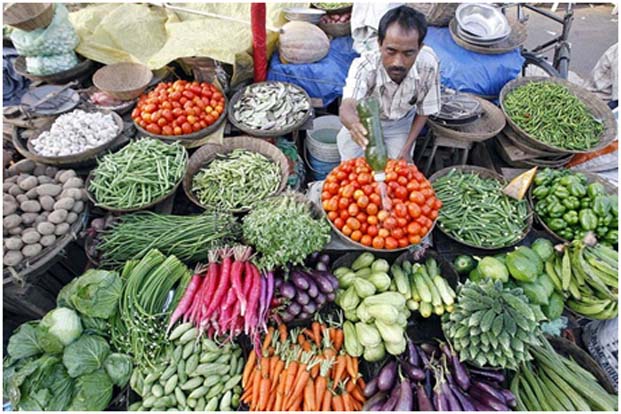Blog
Category
Why don’t Indian Farmers Grow More fruits and vegetables?
In India, rice and wheat comprise 70 percent of agricultural produce by area, but less than 25 percent by value. In other words, wheat and rice are low value crops to grow compared to other options. Yet, the land area dedicated to wheat and rice has not seen a significant decrease in the last decade.

Government data shows that the consumption of wheat and rice has been declining around 1-2 percent in both urban and rural India, while the demand for fruits and vegetables has been rising by 2-3 percent annually. This again begs the question: Why aren’t farmers shifting to growing more fruits and vegetables?
Furthermore, detailed studies across the country have also shown that while farmers just about break ev en (gross return compared to gross costs) on cultivating wheat and rice, growing fruits and vegetables is a profitable undertaking (gross returns are on average double the costs). Besides fruits and vegetables, there are also other crops that generate a higher income than wheat and rice. Having gone through these reports and data, I have been wondering why, despite all this, do farmers choose to grow mostly and rice?
In other words, if Indian consumers are demanding more fruits and vegetables, and these crops are more lucrative anyway, why do Indian farmers keep growing more and more wheat and rice?. Are farmers completely unaware of the difference in returns? Or, is it that despite knowing the disadvantages they choose to grow wheat and rice?
The first possibility seems rather difficult to believe. While I am sure farmers have not created a detailed profit and loss statement for growing wheat versus okra, it is unlikely that farmers are completely ignorant. They probably do have a rough idea of probable market prices, input costs and likely profits.
So what is it about fruit and vegetables that keeps farmers from growing them?.
- Minimum support price: Wheat and rice come with a government minimum support price, and fruits and vegetables don’t. Farmers find it reassuring to know that MSP exists and may influence open market prices and/or demand for their produce.
- Risk of crop failure: Pulses, fruits and vegetables are more vulnerable to adverse weather, leading to higher risk of failure. Rather than pay for crop insurance (where it is available), farmers prefer to simply avoid these crops.
- Care and effort required in cultivation: Wheat and rice require less care and effort to grow than vegetables. Higher care for crops means reduced availability of farmers for alternate income-generating activities, whether crafts or wage labour.
- Need to sell quickly due to lack of storage facilities: India has about 5400 cold storage units, the majority of which are appropriate for potatoes. So farmers don’t really have much of an option to store fruits and vegetables for later. The need to sell immediately means that they are at the mercy of current market prices, unlike grains that can be held on to for a longer time.
- Price volatility: Fruits and vegetables experience a much higher degree of price volatility than grains. Part of the reason for this is the high level of mismatch between demand and supply of fruits and vegetables. Another reason is the inefficiency of markets in matching supply and demand in different parts of the country. And of course, their inherent perishability and lack of cold-chain is an additional worry.
- Price realization due to spoilage: Lack of proper storage and transport facilities has yet another impact – spoilage of produce resulting in lower price realization due to poorer quality of produce by the time it reaches markets. For example, I saw cracked coconuts at a sorting-grading facility – damage that could easily have been avoided with proper packing (and better roads).
- Stored crops as financials assets: As one agri-expert put it, farmers treat grains like fixed deposits, for lack of other ways of saving/keeping money. Repeatedly, farmers told me that they store grains and sell them off as and when the need for cash arises. You simply can’t do that with fruits and vegetables! Even cold storage would extend the life of fresh produce by only so much (unless processed, of course).
- Dignity of transaction: Recent discussions with farmers revealed another reason for medium to large land-holding farmers not growing vegetables. Typically, vegetables are harvested and sold in smaller quantities at a time. When selling wheat, a large landholder farmer can arrive in the mandi with a truck-load full of wheat and be treated with respect. But if he arrives with a small vehicle of veggies, he will be treated just like small and marginal farmers without much respect and dignity. It is interesting to note how class dynamics plays into decisions about what to grow.
Almost all of the reasons listed above relate to risk – either production risk, logistics risk or market risk. Only two non-risk reasons can be seen in the list besides dignity of transaction: the opportunity cost of choosing crops which require greater care, and use of stored crops as financial assets. In principle, the latter can be addressed with better financial access for small holder farmers.
Typical solutions to risk management are insurance products, but typical crop insurance products cover only a limited subset of these risks. And in any case, insurance subscriptions in India have been much lower than hoped for by policy makers and non-profits alike.
Out of intellectual as well as professional curiosity, I have being digging deeper into this question, with the help of field visits and people working in the agricultural sector. Here are the results from my own observations and discussions with agri-sector professionals and experts.
